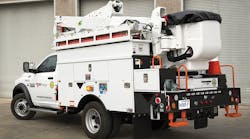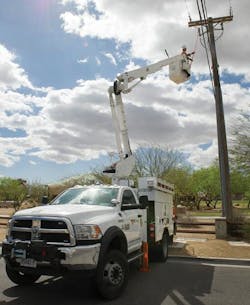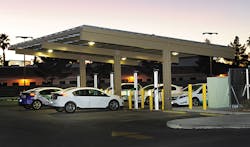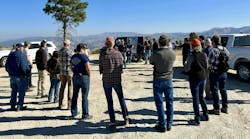When the direct-current electricity enthusiast Thomas A. Edison was designing the electricity distribution system in Virginia City, Nevada, in the early 1900s, he likely had no idea that a century later, the statewide electricity provider would be using DC battery-powered bucket trucks to fix overhead lines and that DC-powered vehicles could successfully traverse the Silver State.
Such is the case today, as NV Energy has embraced a leadership role in using electric-powered bucket trucks and in helping Nevada build the infrastructure necessary to support electric vehicles (EVs) throughout the 110,000-sq-mile state.
Why Hybrid Electric Bucket Trucks?
Linemen like their tools and seldom like change. But the benefits of fuel efficiency, quiet operation and environmental friendliness of battery-assisted hybrid electric bucket trucks could not be ignored.
A typical bucket truck uses a single high-performance internal combustion engine to move the heavy truck and its attached equipment and tools to the job site. Once on site, a secondary drive shaft is engaged through “Power Take Off” (PTO) to turn a hydraulic pump that is used to power outrigging stabilizers, the bucket boom lift and other necessary equipment.
By comparison, the hybrid bucket truck uses a standard diesel internal combustion engine to drive the bucket truck on the road. But the difference is that a mid-vehicle electric motor is used to power the hydraulic system. A dozen high-capacity battery packs support the motor but also can run lights, cab air conditioning and an inverter system to power computers and other standard tools and devices that need 120-V power.
Prior to using these new hybrid bucket trucks, NV Energy’s linemen were forced to leave their trucks in an idling mode while working. This can be noisy to neighbors, especially when the engine races to provide the necessary hydraulic pressure to extend the outriggers or lift the bucket. This idling and engine racing run up gasoline and maintenance costs, and results in emitting extra exhaust fumes. And the constant engine noise makes it harder for crew members to hear safety cautions, to properly respond to guidance commands or to communicate with customers.
During neighborhood blackouts, a loud line truck would be a welcomed sound to all those waiting to have their power restored. But other times, when crews need to perform routine maintenance in quiet neighborhoods during the early hours of the day, the new quieter hybrid trucks are a welcomed relief to energy company customers and neighborhood activities.
NV Energy has been expanding its hybrid fleet since the first hybrid bucket trucks were available in 2009. Out of its 900 vehicles, the utility has about 50 hybrid bucket or line trucks for troublemen and line crews, and more than a dozen passenger vehicles that are used by various company departments.
Operating Hybrid Trucks
Every company has different budget pressures and cost parameters, but NV Energy has opted for building up a hybrid line fleet, rather than purchasing the more expensive trucks that run exclusively on electricity. A related reason is that the company’s service territory stretches 45,592 sq miles, and often trucks must travel great distances to repair storm-damaged lines or respond to customer needs.
Purchased from Altec Inc., these hybrid electric trucks can be either plugged in at the company’s service center, or their batteries can be charged by the truck’s internal combustion engine. The batteries and internal electrical system power the aerial devices, cool the cab and provide up to 3,000 W of 120 V of electricity for a wide variety of internal and external needs. This avoids hauling a power generator and fuel to the jobsite.
After arriving at the job location, the diesel-fueled engine is shut off completely, the parking break is set, and the outriggers are put down. When linemen first switch to these hybrid trucks, they often comment that they enjoy hearing the sounds of nature and sounds of a neighborhood that previously could not be heard above the idling engine noise. The only sound that interrupts this much quieter environment is a soft hum of the electric motor and hydraulic pump.
In the single-operator hybrid bucket trucks used by NV Energy, the control box is always in the “electronic Power Take Off” mode. If for some reason the electronic PTO is not functioning properly, the operator can turn the key in a control box and run the truck in regular PTO mode.
If the electricity-powered hydraulics experience a problem or run out of battery energy, the truck’s diesel engine will automatically start to charge the batteries. The NV Energy trouble crew has not experienced any major problems since using the units for the past 18 months.
A major advantage of the electric PTO mode is its ability to quietly, and in an environmentally friendly manner, keep the AC pumping into the cab. This is important in the Las Vegas valley, where temperatures can soar to up to 120°F or more. At those temperatures, the waiting AC is a welcomed relief and safety benefit to hard-working linemen. Similarly, temperatures in Nevada dip below freezing during the winter, and the system can keep the cab and crew warm.
The hybrid system can accommodate strong lighting for nighttime conditions, and the built-in inverter can even provide emergency power to a customer until the power is restored. In some cases, linemen have provided critical power to run a customer’s oxygen machine while making repairs to primary or secondary lines and equipment.
Training the Field Workforce
NV Energy has a top-decile safety culture, and all individuals who were slotted to use the new electric hybrid trucks were required to attend an orientation and training class provided by Altec. The two-and-a-half-hour class included hands-on training, scenario discussions and question response; proper PTO sequencing and safety guidance were a priority.
While not all of the linemen were on board with the new technology at first, they quickly learned that the trucks were simple to operate. Some, for example, worried that they could be stuck up in the air in the bucket with dead battery packs, but they quickly develop confidence in the system, because the internal-combustion engine automatically starts up when the battery packs run low.
NV Energy continues to explore alternative-fuel vehicles. For example, the utility invested in light-duty electric cars that can travel from office to office or to meet with customers or other constituents. In addition, the company is constantly reviewing the cost and benefits of all-electric pickup trucks and continuing to push this initiative forward.
Taking a Green Fleet to the Next Level
In 2014, NV Energy joined an Edison Electric Institute pledge with more than 70 electric utilities to devote at least 5% of its annual fleet acquisition budget to purchasing plug-in EVs and support related technologies. This industrywide initiative aligns with a White House focus and U.S. Department of Energy goal to cut carbon pollution and reduce the nation’s dependence on foreign oil.
NV Energy also continues to look for other opportunities to help its customers access a lower-cost fueling option for commuters, avoid fuel-price uncertainty (compared to fluctuating gasoline prices) and embrace options that benefit the Nevada environment and economy.
Nevada Electric Highway
NV Energy is committed to helping its customers meet their sustainability goals. In 2009, the company offered EV time-of-use rates that offered both vehicle charging and overall home energy cost benefits to Nevada customers. However, EV ownership and use in Nevada was relatively low, compared to neighboring states in the West.
The company identified that one of the major barriers to EV adoption is “range anxiety,” which refers to a lack of public-charging resources and concerns that an all-electric vehicle could be stranded between charges. To continue its support of the EV market, in 2013, the company partnered with more than 50 of its major customers to double the number of EV charging locations throughout the state. Now, thanks to the shared-investment strategy initiated by NV Energy, their customers and tourists can charge their vehicles at airports, shopping malls, universities, resorts, public buildings, hotels and key businesses throughout the state. In exchange for the support from NV Energy, the hosting entity agreed to provide free vehicle charging to the consumer for the first five years.
NV Energy’s current focus is to help build the “Nevada Electric Highway,” which will enable EV drivers to access a network of charging stations along a 437-mile trek between northern and southern Nevada along U.S. Route 95. To address the ambitious goal of building a long-distance DC fast-charging network, NV Energy partnered with Nevada’s Governor’s Office of Energy and the Nevada Department of Transportation to connect the state. Both NV Energy and the state have provided incentives to facilitate a shared investment to those desiring to host charging stations along the strategically sited route that use fast-charge technology and level-two charging systems, which will also be free to EV drivers for the first five years of the program.
Thanks to the leadership shown by NV Energy, the State of Nevada and others, a greater number of fleet owners are evaluating opportunities to expand their adoption of economically viable alternative-fuel vehicles that will continue to benefit the environment of Nevada and the West.
Chris Charlton is a line troubleman with NV Energy and has been with the company for the 19 years.
Marie Steele is the manager of electric vehicles and renewable energy for NV Energy.




